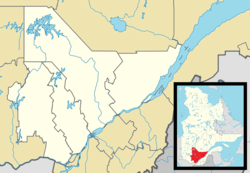Basilica of Sainte-Anne-de-Beaupré
| Basilica of Sainte-Anne-de-Beaupré | |
|---|---|
 Basilica of Sainte-Anne-de-Beaupré | |
| Location | Sainte-Anne-de-Beaupré, Quebec |
| Country | Canada |
| Denomination | Catholic Church |
| History | |
| Status | Basilica |
| Architecture | |
| Functional status | Active |
| Architectural type | Norman-Gothic, Romanesque Revival |
| Completed | 1946 |
| Specifications | |
| Length | 105 m (344 ft) |
| Width | 48 m (157 ft) |
| Spire height | 91 m (299 ft) |
| Administration | |
| Archdiocese | |
| Type | Recognized heritage immovable |
| Designated | 2001 |
| Reference no. | 93392[1] |
The Basilica of Sainte-Anne-de-Beaupré is a basilica set along the Saint Lawrence River in Quebec, Canada, 30 kilometres (19 mi) east of Quebec City. It has been credited by the Catholic Church with many miracles of curing the sick and disabled. It is an important Catholic sanctuary which receives about a half-million pilgrims each year, including the Anna Fusco Pilgrimage from Connecticut. The peak period of pilgrimage is around July 26, the feast of Saint Anne, the patron saint of Quebec.
Legend
St. Anne is believed, by the pious, to obtain miracles through her intercession. People from all around the world come to visit the basilica. Pillars in the front entrance are covered in crutches from people who are said by the parishioners to have been miraculously cured and saved.

History
The basilica in Sainte-Anne-de-Beaupré was initially a shrine to honour Saint Anne. On March 8, 1658, a man by the name of Etienne de Lessard donated two frontal acres from the West end of his property to the Catholic Church so that a chapel could be built. This chapel eventually became the site of the modern-day basilica. It was built for two reasons: to provide a place of worship for the new settlers in the area [2] and to house a miraculous statue of St. Anne.[3] The first reported miracle at the site happened during the shrine’s construction. A man named Louis Guimond was hired to help build the shrine even though he suffered from rheumatism. After placing three stones upon the shrine’s foundation, Guimond was cured of all his ailments.[2] This was followed by other testimonies of healed people and the shrine soon grew in popularity. Many pilgrims came to the shrine hoping to receive a miracle while others like Anne of Austria supported the shrine from their homes.[4]

Because of the popularity of the shrine, the building was enlarged several times to accommodate all the pilgrims. In 1876, the first basilica opened for worship. The former basilica was destroyed in a fire on March 29, 1922.[2] The present-day basilica was built on the site of the prior church in 1926.

Architects Maxime Roisin, Louis N. Audet and Joseph-Égilde-Césaire Daoust collaborated on the project from 1923-1931. After the end of the financial recession, the work on the interior resumed in 1937, and was finally completed in 1946.[5]
Miracles are still believed to be performed at the basilica. When entering the church one can see two pillars filled with racks of crutches, canes, braces, and other signs of disabilities. Every item has been left by a pilgrim who reports being healed at the basilica.
The wooded hillside next to it has a memorial chapel and a Way of the Cross, with life-sized Stations of the Cross. Higher up the hill the Convent of the Redemptoristines can be found. Built in 1906 and declared a historic site in 2001, it has been abandoned in the recent years.
Interior
Joseph-Émile Brunet designed twenty-four capitals (1948) for the Basilica of Sainte-Anne-de-Beaupré, which depict 52 religious subjects reflecting the life of Jesus. He sculpted 14 “Stations of the Cross” lining the walls of the Cathedral, with stone statues of Saint Anne and Saints at the entrance of the Cathedral. Joseph-Émile Brunet also created the fountain in front of the Basilica and the 7' 6' high stone sculpture in niches as you enter the basilica, “Marie de L’Incarnation”, “Saint Joseph”, “The Virgin with Jesus”, ““François de Laval”, and “St. Joachim”, in addition to a bronze sculpture of Kateri Tekakwitha, 6’ 4” high.[6]
Dimensions
- Total length : 105 meters (344 ft)
- Face width : 48 meters (157 ft)
- Transept width : 61 meters (200 ft)
- Steeple height : 91 meters (299 ft)

Basilica plan
Notes
- ^ Ministère de la Culture et des Communications. "Basilique de Sainte-Anne-de-Beaupré". Répertoire du patrimoine culturel du Québec.
- ^ a b c Lebel, Jean-Marie; Ostiguy, Birgitte (1999). "Saint Anne de Beaupré: An Inspiration" (Document). Les Editions du Chien Rouge.
- ^ "Basilica of Sainte-Anne de Beaupré, Quebec". Sacred Destinations. Retrieved 2007-03-24.
- ^ Morinis, Alan. "Pilgrimage". Canadian Encyclopaedia. Archived from the original on 2007-09-30. Retrieved 2007-03-24.
{{cite encyclopedia}}: Unknown parameter|deadurl=ignored (|url-status=suggested) (help) - ^ "biography in Biographical Dictionary of Architects in Canada 1800-1950". Retrieved November 16, 2011.
- ^ http://www.lhaywardcollection.com/index_files/Page887.htm Joseph-Émile Brunet
-
Interior of the basilica
-
Joseph-Émile Brunet's bas relief Basilica of Sainte-Anne-de-Beaupré
-
Joseph-Émile Brunet's Kateri Tekakwitha” Basilica of Sainte-Anne-de-Beaupré
-
Joseph-Émile Brunet's "Mary and Jesus" Basilica of Sainte-Anne-de-Beaupré
-
Underground chapel in the crypt
External links
- Basilica of Sainte-Anne-de-Beaupré
- Cardwell, Mark (2008-03-22). "Basilica a shrine for miracles". Montreal Gazette. canada.com. Archived from the original on 2009-09-05. Retrieved 2008-03-22.
{{cite news}}: Unknown parameter|deadurl=ignored (|url-status=suggested) (help) - Basilica of Sainte-Anne-de-Beaupre: Photo Gallery by The Catholic Photographer
- Google 3D warehouse
- Shrine of Saint Anne de Beaupré, near Québec City (1926)
- Ste-Anne-de-Beaupré in Canadian Encyclopedia







